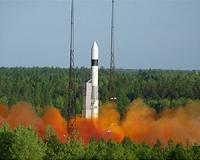 |
for Launchspace Bethesda MD (SPX) Jun 03, 2010 Almost 20 years ago, Iridium, ICO, ORBCOMM and other telecom companies got serious about launching hundreds of communications satellites to low- and medium-altitude orbits. The objective was to establish constellations which could provide continuous worldwide coverage for telephony and data relay services to users with special handsets and other devices. This was a time when cellular systems were just getting into cities, but had limited coverage outside metropolitan areas. Most of the world did not have instant mobile communications access for business and personal use. Launch vehicle entrepreneurs saw an opportunity to provide cheap access to space by developing reusable launch systems. By the early 1990s, we saw a half dozen startup companies raising capital in order to develop reusable launch vehicles (RLVs). Of the many who tried, Kistler Aerospace was the leader in finding investors and raised several hundred million dollars in an effort to create a two-stage fully-reusable system, the K-1. Kistler was the best funded and had the most credible design of all the new companies. Unfortunately, we will never know if that design would have worked. Several adverse events resulted in the ultimate demise of the Kistler enterprise. Development costs exceeded available capital. Design changes added to the costs. And, finally, the satellite telecom industry went bust as the new century started. Thus, the market for reusable launch systems disappeared and capital markets dried up. Kistler and other startup companies eventually dissolved and "RLV fever" subsided. Since the early 2000s there has been renewed interest in reusable systems. The Air Force continues to pursue reusable stages for military applications, but little progress has been made toward any operational systems. The private sector is focused on suborbital launch systems for human tourism. The good news is that human space tourism represents a potentially huge market and entrepreneurs are working on operational passenger flights that may begin soon. The bad news is that reusable flights to orbit, either uncrewed or crewed, still await the impetus needed to raise enough capital to develop such systems. What is needed to get the ball rolling? The answer is simple. RLV needs a "killer" space application that is best served by RLV systems. Today, there is no such application. However, that could all change rather rapidly. For example, as space debris continues to clog low Earth orbits, one day several hundred valuable space assets may have to be moved to lower orbits. This reconstitution of space assets would likely lead to launching several hundred satellites for an indefinite period of time. RLVs are ideally suited for low orbit injection and the high frequency of launches would justify the large development cost. Each flight could be as low as 20% of today's cost. Another scenario that could justify RLV development is popular human tourism to orbit. So, RLV lovers, there is hope. Don't give up.
Share This Article With Planet Earth
Related Links Launchspace Launch Pad at Space-Travel.com
 Rockot Launches Japanese SERVIS-2 Satellite
Rockot Launches Japanese SERVIS-2 SatelliteBremen, Germany (SPX) Jun 03, 2010 We announce the successful launch of the SERVIS-2 satellite at 01.59 h UTC from Plesetsk Cosmodrome in Northern Russia using a ROCKOT launch vehicle. The spacecraft was injected into a sun-synchronous orbit of 1200 km altitude. The SERVIS-2 mission is the successor to SERVIS-1 also successfully launched on a Rockot in October 2003 by Eurockot for its Japanese customer, the Institute for Un ... read more |
|
| The content herein, unless otherwise known to be public domain, are Copyright 1995-2010 - SpaceDaily. AFP and UPI Wire Stories are copyright Agence France-Presse and United Press International. ESA Portal Reports are copyright European Space Agency. All NASA sourced material is public domain. Additional copyrights may apply in whole or part to other bona fide parties. Advertising does not imply endorsement,agreement or approval of any opinions, statements or information provided by SpaceDaily on any Web page published or hosted by SpaceDaily. Privacy Statement |